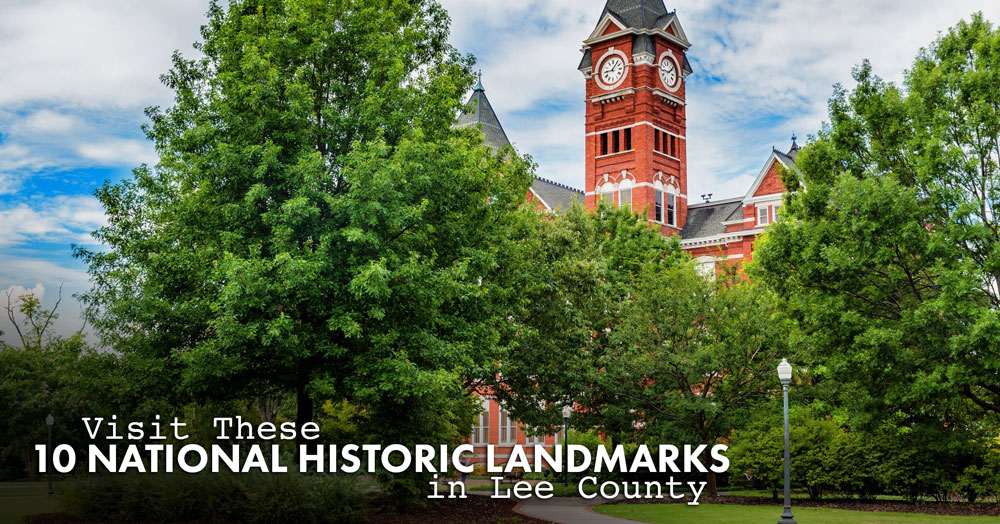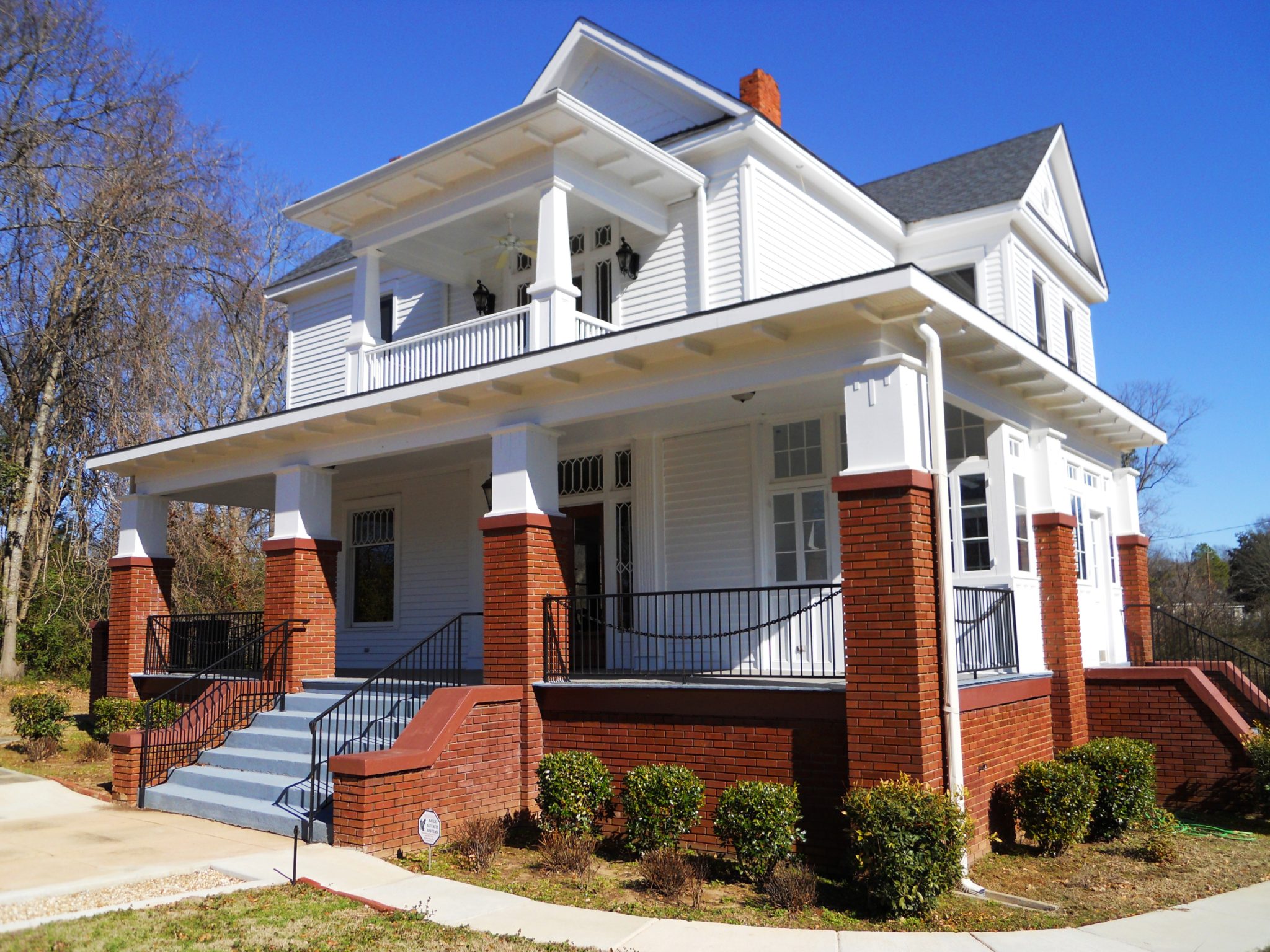
Part of appreciating your city is understanding the culture and history that is associated with it. The place that we call The Plains and its sister city Opelika has a rich past that goes beyond who won the Iron Bowl each year and how many times we’ve rolled the Toomer’s trees. In some instances, a structure stills stands that is worthy of having earned a place on the National Register of Historic Places, while in others, all that is left to signify that something significant once happened there is a metal sign adorned with a brief explanation of events. If you are interested in getting to know your town better, visit these 10 national historic landmarks in Lee County.
Photo courtesy of Rivers Langley via Wikipedia
Auburn Players Theater/Auburn University Chapel, 139. S. College Street
Built in 1851 as a Presbyterian Church, this chapel briefly served as a Confederate hospital for wounded soldiers during the Civil War. In 1921, the building was sold to what was then the Alabama Agricultural and Mechanical College, where it became the YMCA/YWCA for a few years. From 1927 to 1973, the building housed the college’s acting group, the Auburn Players. Today, it serves as an interdenominational, multipurpose building. Date added to historic register: May 22, 1973.
Auburn University Historic District, Auburn University campus
This 14.5-acre district encompasses the core of the Auburn University campus and includes buildings built between 1846 and 1951 that employ the characteristic red brick in their architecture. Buildings include Samford Hall, The Lathe, Langdon Hall, Broun Engineering Hall, Mary E. Martin Hall, Biggin Hall and others. Date added to historic register: June 3, 1976.
Photo courtesy of Rivers Langley via Wikipedia
Ebenezer Missionary Baptist Church, Thach Street and Auburn Drive
This was the first African American church built in the Auburn area following the Civil War in 1865. The church was built from hand-hewn logs by its members and was completed circa 1870. It served the Ebenezer congregation for nearly 100 years. The church building was restored in 1970 by the Auburn Heritage Association, and today it houses the Auburn Unitarian Universalist Fellowship. Date added to historic register: May 21, 1975
Photo courtesy of Rivers Langley via Wikipedia
Loachapoka Historic District, Both sides of Alabama Highway 14 in Loachapoka
Originally a Native American settlement before the forced migration to the West, “Loachapoka” translates to “land where turtles live,” or “turtle killing place.” Pioneer families established themselves in the area after 1836. The historic district includes 14 antebellum homes, two churches from the 1840s, the Lee County Historical Society Museum and a 100-year-old school house. Date added to historic register: May 11, 1973
Photo courtesy of Rivers Langley via Wikipedia
Old Rotation, Auburn University campus
A soil fertility experiment on Auburn University’s campus, Old Rotation was initiated in 1896. It is the third-oldest ongoing field crop experience in the United States and the oldest continuous cotton experiment in the world. Professor J.F> Duggar of what was then the Alabama Agricultural and Mechanical College started the Old Rotation experiment on a one-acre plot of land south of campus to test whether it would be beneficial for the soil’s nutrients to plant legumes on the same land as the cotton, but during the winter when cotton doesn’t grow. This rotation has continued ever since. Date added to historic register: January 14, 1988
Photo courtesy of Wikipedia
Pepperell Mill and Mill Village Historic District, Pepperell Parkway, Opelika
Founded in 1925, Opelika’s Pepperell Mill served the city’s largest industry until it closed in 2006. The surrounding village supported the mill workers and was constructed between 1925 and 1940 by the Pepperell Manufacturing Company. The village originally included 100 homes, but by 1946 it had grown to 240 buildings that included houses, a church, school, grocery store, post office, drug store, barber shop, gas station and childcare facility. In 1958, the company began selling house lots to individual owners. Seventy percent of the Mill was lost to fire in March 2013. Date added to historic register: March 31, 2014.
Photo courtesy of Rivers Langley via Wikipedia
Spring Villa, Spring Villa Road, Opelika
Constructed in 1850 next to a 30-acre spring-fed lake, Spring Villa is one of about 20 remaining residential examples of Gothic Revival architecture remaining in the state. The plantation home was acquired by the City of Opelika in 1927 and now serves as the centerpiece of the 325-acre Spring Villa Park. It is said that the structure is now haunted by the ghost of its builder, slave owner William Penn Yonge. It was added to the National Register of Historic Places on account of its architectural significance. Date added to historic register: January 3, 1978.
Photo courtesy of Rivers Langley via Wikipedia
Dr. J.W. Darden House., 1323 Auburn St., Opelika
This historic home was built in 1904 by Opelika’s first African American doctor, J.W. Darden—who was also the old physician available for African Americans within a 30-mile radius of Opelika. Darden operated his practice from the home in the 1940s, during which time it also became a social and political center for the local African American community. Prominent visitors to the house include Booker T. Washington, George Washington Carver and A.G. Gaston. Today, the building houses the J.W. Darden Wellness Center and also acts as an event space. Date added to historic register: August 12, 2009.
Photo courtesy of Rivers Langley via Wikipedia
Noble Hall, Shelton Mill Road, Auburn
Also known as the Frazer-Brown-Pearson Home, Noble Hall is a Greek revival plantation house that was built in 1854 as the main residence of a 2,000 acre cotton plantation. During the Civil War, the home housed sick and injured Confederate soldiers. When Union troops came to ransack the mansion toward the end of the war, one of its residents showed a Masonic sign, and troops were persuaded to only take horses and mules. The home changed hands over the years and was sold to Alabama Polytechnic Institute president Luther Noble Duncan in 1941. His daughter inherited it in 1951, after which she named it Noble Hall after her father. It was the first structure in Lee County to be listed on the National Register of Historic Places. Date added to historic register: March 24, 1972.
Photo courtesy of Rivers Langley via Wikipedia
Scott-Yarbrough House, 101 Debardeleben St., Auburn
Also known as Pebble Hill, the Scott-Yarbrough House is an antebellum cottage that was constructed by Col. Nathanial J. Scott in 1847 at the center of a 100-acre plantation. Wilson’s Raiders attempted to pilfer the home during the Civil War, but most of the valuables had been buried by a nearby spring. After seeing several owners over the decades, Cecil S. Yarbrough purchased the home in 1912. Yarbrough was a state representative and three-time mayor of Auburn. The home remained in the Yarbrough family until 1974, when it was purchased and restored by the Auburn Heritage Association. Today, it serve as the location of the Caroline Marshall Draughon Center for the Arts & Humanities for Auburn University’s College of Liberal Arts. Date added to historic register: April 16, 1975.
These are only a handful of historic landmarks in Lee County that have been listed on the National Register of Historic Places! Get to know your community better by being aware of the people and places that made their marks on the place that we call home before we came to be here.
To learn more about the Auburn and Opelika area, continue to follow the Ryan Roberts Realtor blog! And for your real estate needs in Auburn, Opelika and Lake Martin, contact Ryan Roberts at 334-750-9872, or email [email protected]!














